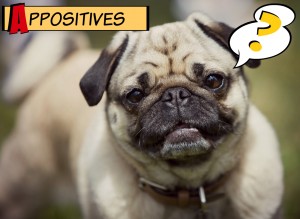Positive about Appositives?

There are many literary ways to give your writing more depth, make things more clear, and paint pictures for your readers. Metaphors, ellipses, and the like are well known and often used stylistic devices used for such purposes. However, how positive are you about the usage of appositives?
What’s An Appositive?
Maybe it’s for the best if we explain to you what an appositive is first. It could be that you used it before, and it’s very likely that you have seen it in articles, books, and other reading material before. But did you recognize it?
From a linguistic standpoint, appositives are either nouns or noun phrases that rename a noun they are paired with. Have a little example:
- My dog Sally, a pug, is quite sneaky when she wants to get a treat.
The appositive in the sentence is a pug, renaming or further specifying the phrase of my dog Sally. Since the breed of the dog is, at first glance, not essential to the meaning or understanding of the sentence, it is separated from it using commas.
Functions Of The Appositive
As stated above, the appositive renames or restates a noun or noun phrase, but for which purpose? The information given in the appositive is not mandatory to understand the meaning of the sentence – it could be omitted just as well. Thus, it merely serves to give further information about the noun or phrase in question.
- Sally, who loves long romantic walks to the fridge, is a very well-behaved pug.
The information given in the appositive (here: who loves long romantic walks to the fridge) isn’t any essential information about Sally. This points at the fact that appositives can easily be omitted or cut out of a sentence without changing it’s meaning:
- Sally is a very well-behaved pug.
Visual Traits
Besides being easily recognized by it’s optional status, appositives are easily recognized by being enclosed by commas. This represents the text-book way of indicating an appositive. However, some authors also favor the method of separating appositives using an em dash:
- My pug — as annoying as she may be — is my best friend.
Position
While appositives, in most cases, interrupt a sentence – and the flow of reading – they can occur in other positions of a sentence as well. Namely at the beginning:
- A world-famous show-pug, Bernadette won er third award this season.
And at the end:
- Everyone loves Bernadette, a world-famous show-pug.
